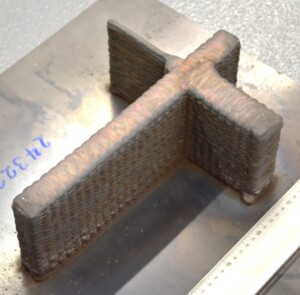Introduction to Wire DED
Introduction to Wire DED
From Repair to Production: High Deposition, Industrial Strength
Wire-based Directed Energy Deposition (Wire DED) is a category of metal AM technologies known for their ability to build large parts quickly by melting metal wire with a focused energy source. Whether using electric arc, plasma, laser, or electron beam, Wire DED stands out due to its high deposition rate, material cost-efficiency, and ability to build onto existing components.
This overview introduces the key lessons in the course and summarizes what you’ll learn about Wire DED—from technology fundamentals to process economics and supplier landscapes.
You can then go through the course from start to finish or directly jump to the section you are most interested in.

What you will find in this section
Process Variants & Technology Landscape
Learn how the energy source defines the process—and the supplier ecosystem
Wire DED is not a single technology, but a family of variants distinguished by the energy source:
Wire Arc and Plasma Arc Deposition
Wire Laser Energy Deposition
Wire Electron Beam Energy Deposition
These sub-technologies vary in complexity, precision, and machine availability. Wire Arc is the most widely adopted, but Wire Laser and Electron Beam are rapidly gaining ground due to advances in deposition control and system automation.
You’ll explore how each works, what it’s best used for, and who supplies it.
Applications
See where Wire DED is used—and why it matters
Wire DED is ideal when speed and material volume matter more than ultra-fine detail. Applications include:
Repair & Coating
Repair & Coating
Feature Addition
Feature Addition
Tooling
Tooling
Casting & Forging Replacement
Casting & Forging Replacement
Real examples include titanium brackets for Boeing, turbine runners in hydropower, and gearbox housings in heavy industry.
Digital Process Chain
Understand the digital thread: CAD - CAM - CNC
Wire DED requires a digital toolchain that turns 3D geometry into machine-ready code:
CAD
CAD
CAM
CAM
CNC Control
Tooling
You’ll learn about the challenges of 5-axis programming, geometry simplification, and simulation-based validation—and why toolpath generation still requires expert know-how.
Technology Capabilities
See how each Wire DED system performs in real-world benchmarks
Based on AMPOWER’s benchmark study using 9 real parts, you’ll review:
Build rates
Build rates
Surface waviness
Surface waviness
Minimum wall thickness
Minimum wall thickness
Feature size vs. speed
Feature size vs. speed
You’ll also understand key trade-offs: higher speed often means rougher finish or lower detail resolution.
Production Cost
Understand the cost per kg—and how to reduce it
Wire DED is more cost-efficient than L-PBF for larger parts due to
Cost Structure
Cost Structure
DED vs. L-PBF
DED vs. L-PBF
Cost Reduction
Cost Reduction
You’ll learn about the challenges of 5-axis programming, geometry simplification, and simulation-based validation—and why toolpath generation still requires expert know-how.
Feedstock
Explore wire sourcing, pricing, and quality factors
Wire feedstock is still maturing. This lesson covers:
Sourcing models
Sourcing models
Pricing
Pricing
Delivery formats
Delivery formats
Wire straightness
Wire straightness
You’ll also explore how DIN EN ISO 544 defines wire tolerances, and how container size affects machine uptime.
Standards & Guidelines
Understand how Wire DED is qualified and regulated
Standardization is catching up with industry adoption. You’ll learn:
